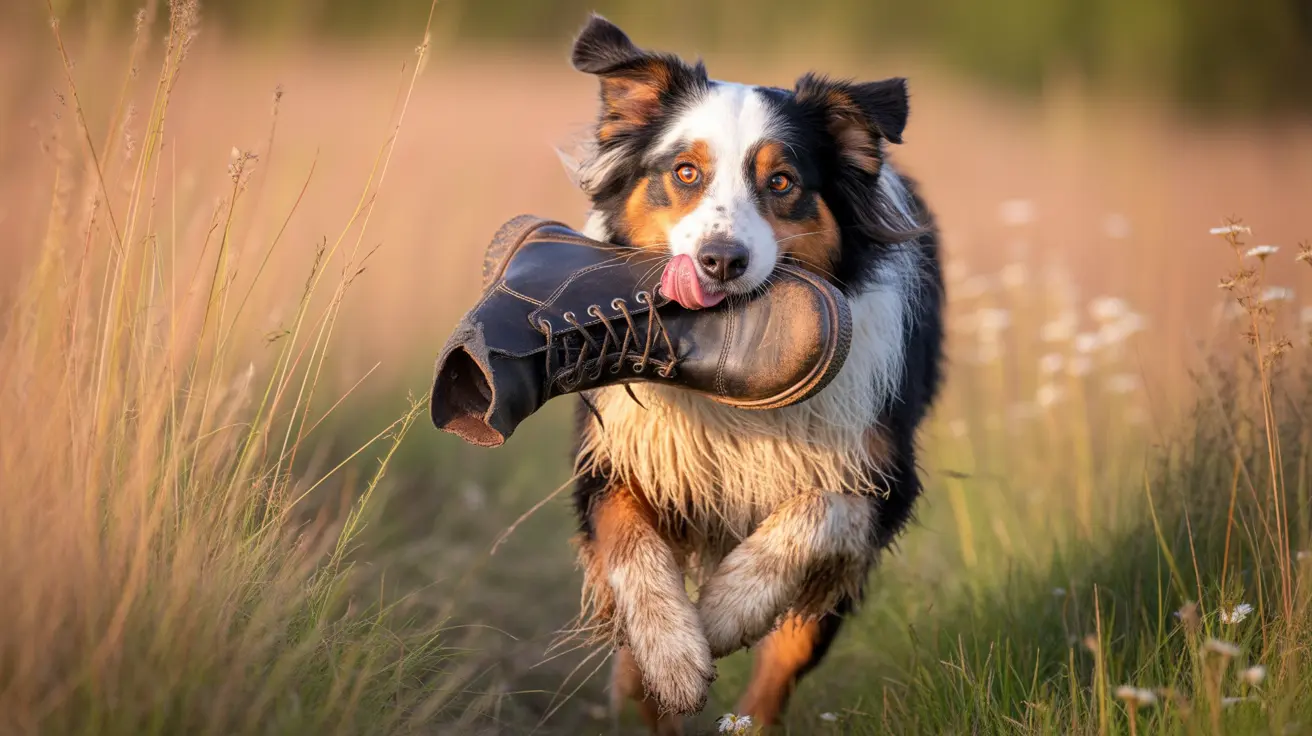Why Does My Dog Take Forbidden Items and Run Away? Expert Solutions to Stop This Frustrating Behavior
If you've ever watched in frustration as your dog grabs your favorite shoe, remote control, or child's toy and takes off running, you're not alone. This common canine behavior leaves many pet owners feeling exasperated and wondering why their furry friend seems to enjoy turning everyday items into contraband. Understanding why dogs take forbidden items and run away is the first step toward addressing this challenging behavior effectively.
The truth is, your dog isn't trying to be malicious or deliberately disobedient. From their perspective, they're often engaging in what they perceive as a fun game or responding to natural instincts. Most dogs don't understand human concepts of ownership the way we do, and what appears to be "stealing" to us is simply exploration, play, or attention-seeking behavior to them. The key to resolving this issue lies in understanding the underlying motivations and implementing both management strategies and targeted training techniques.
In this comprehensive guide, we'll explore the psychological reasons behind this behavior, help you distinguish between harmless play and potentially problematic resource guarding, and provide you with proven strategies to manage and modify your dog's item-taking habits. Whether you're dealing with a playful puppy or an adult dog with established stealing patterns, you'll find practical solutions to restore peace to your household.
Understanding Why Dogs Take Forbidden Items
Dogs explore the world primarily through their sense of smell and mouth, making it natural for them to investigate interesting objects by picking them up. When your dog takes forbidden items, they're often drawn to objects that carry your scent or seem particularly intriguing. Items like dirty laundry, shoes, and personal belongings are especially appealing because they smell strongly of their beloved human family members.
The behavior often becomes reinforced through what behaviorists call "owner-inadvertent encouragement." Here's how this typically develops: your dog picks up an item they shouldn't have, you immediately jump up and chase them, which feels like an exciting game to your dog. When you finally catch them and pull the item from their mouth, it resembles a fun game of tug-of-war. The next time your dog wants attention or entertainment, they remember this successful strategy and repeat it.
Boredom and lack of mental stimulation also play significant roles in stealing behavior. Dogs need both physical exercise and mental challenges to prevent them from creating their own entertainment. When left to their own devices without adequate enrichment, many dogs will naturally gravitate toward exploring household items, especially if they're unsupervised.
Recognizing the Difference: Play vs. Resource Guarding
It's crucial to distinguish between playful stealing and more serious resource guarding behaviors, as they require different approaches. Playful stealing typically involves your dog grabbing an item and then approaching you or staying within view, almost as if they're inviting you to chase them. These dogs often have relaxed body language and may even drop the item voluntarily when they lose interest or get distracted.
Resource guarding, on the other hand, presents with different warning signs. Dogs exhibiting resource guarding behavior may stiffen their body, lower their head over the item, show whale eyes (showing the whites of their eyes), growl, or move away from you while keeping the item. They might also refuse to drop the item even when offered high-value treats, or show signs of stress and anxiety when approached.
If your dog displays any signs of resource guarding, it's essential to avoid confrontational approaches like chasing or forcibly removing items. Instead, focus on creating positive associations and consider working with a professional dog trainer or behavioral consultant who uses positive reinforcement methods.
Management Strategies: Prevention is Your Best Friend
The most effective approach to stopping item stealing begins with prevention. Even while you're working on training solutions, management strategies provide immediate relief and prevent the behavior from being rehearsed and reinforced. Prevention isn't just about avoiding frustration in the moment – it's also crucial for building new, better habits by stopping the rehearsal of unwanted behaviors.
Start by puppy-proofing your home thoroughly. Keep shoes in closets with doors that close, put hampers and garbage cans with secure lids or in cabinets, hang kitchen towels on upper cabinets out of reach, and close bedroom doors. The goal is to make forbidden items inaccessible so your dog can't practice stealing them in the first place.
For areas you can't completely dog-proof, consider using deterrent devices. Motion-activated air sprayers, taste aversives like bitter apple spray on specific items, or even motion detector alarms can help teach your dog to avoid certain areas or objects. When using these tools, ensure they're paired with positive alternatives – provide appealing, appropriate toys and chews in areas where your dog spends time.
Supervision is equally important, especially for puppies and dogs still learning household rules. When you cannot actively supervise your dog, confine them to a safe area with appropriate toys and chews. This prevents unsupervised stealing and gives your dog acceptable outlets for their natural desire to chew and explore.
The Critical Mistake: Why Chasing Makes Everything Worse
One of the biggest mistakes dog owners make is chasing their dog when they steal something. From your dog's perspective, chasing transforms the stolen item into the most valuable prize in the house. Your dramatic reaction – jumping up, calling their name, and pursuing them – signals that this item must be incredibly important and worth protecting.
Chasing also reinforces the behavior by providing exactly what many dogs are seeking: your undivided attention. Dogs who steal for attention learn that grabbing forbidden items is a foolproof way to get you to drop everything and focus entirely on them. Even negative attention is still attention from their perspective.
Additionally, the chase itself becomes a rewarding game. Running games are naturally enjoyable for most dogs, and the combination of your excited energy and the physical activity creates a highly reinforcing experience they'll want to repeat. When you finally catch up and forcibly remove the item, it can feel like tug-of-war – another game many dogs love.
Instead of chasing, your goal should be to make stealing boring and unrewarding. This means staying calm, avoiding direct confrontation, and using strategic techniques to regain your property without turning it into a game.
Training Solutions: Teaching "Leave It" and "Drop It"
Two essential commands form the foundation of addressing stealing behavior: "leave it" and "drop it." These commands work together to prevent stealing before it happens and resolve situations when it does occur. Consistent training with these commands for about 10 minutes daily over at least three weeks typically produces reliable results.
To teach "leave it," start with your dog on a leash, preferably wearing a head collar for better control. Walk your dog toward a low-value training item like a paper bag. As your dog reaches for the item, calmly say "leave it" and gently turn their head away using the head collar. Immediately reward with a treat and praise when they look toward you instead of the item. Practice with increasingly valuable items as your dog masters the concept with easier objects.
For "drop it" training, start with items your dog is allowed to have, like their own toys. When your dog has a toy in their mouth, offer a high-value treat and say "drop it." The moment they release the toy, reward them with the treat and praise. Importantly, give the toy back to them after they've eaten the treat – this teaches them that dropping items doesn't mean losing them permanently, making them more willing to comply in the future.
Practice these commands regularly in controlled situations so they become reliable when you really need them. Remember that consistency is key – every family member should use the same commands and approach to avoid confusing your dog.
The Trade Game: Making Exchanges Rewarding
Teaching your dog to voluntarily trade items is one of the most effective strategies for managing stealing behavior. The concept is simple: make giving up the stolen item more rewarding than keeping it. This approach works because it removes conflict from the situation and teaches your dog that relinquishing objects leads to good things.
When your dog has taken something they shouldn't, calmly approach with high-value treats – things like small pieces of chicken, cheese, or freeze-dried liver that your dog finds irresistible. Instead of reaching for the item, drop several treats on the ground a few feet away from your dog. Most dogs will drop the item to investigate and eat the treats, giving you the opportunity to calmly retrieve the object.
The key to successful trading is using treats that are significantly more valuable to your dog than the stolen item. Regular training treats from the pet store often aren't exciting enough to compete with the thrill of a forbidden object. Think of it like offering someone a $100 bill in exchange for a $50 bill – the trade needs to be obviously beneficial from your dog's perspective.
Start practicing the trade game with items your dog is allowed to have, then gradually work up to practicing with objects they're more likely to steal. Always return non-dangerous items to your dog after they've eaten their reward, reinforcing that trading doesn't mean permanent loss.
Dealing with Dangerous or Valuable Items
When your dog has something that could harm them or is valuable to you, the approach needs modification. Never panic or make sudden movements, as this can cause your dog to swallow the item quickly or become defensive. Instead, stay calm and use distraction techniques that don't involve direct confrontation.
Try making an interesting noise in another room, such as opening the refrigerator door, rattling treats, or even leaving the room to see if your dog follows. Many dogs will drop what they have to investigate the new sound or activity. Once they've moved away from the item, engage them in something positive like eating scattered treats in another room while you safely remove the object.
For extremely dangerous items like medication or toxic foods, you may need to use emergency trading with the highest-value treats you have available. Keep some irresistible emergency treats in your freezer – things like small pieces of cooked steak or chicken – specifically for these situations. The key is acting quickly but calmly to avoid triggering your dog's "flight" response.
If your dog shows any signs of resource guarding with dangerous items – stiffening, growling, or moving away – do not attempt to retrieve the item yourself. Instead, contact a professional dog trainer or veterinary behaviorist immediately for guidance on safely handling the situation.
Creating Positive Alternatives and Enrichment
Addressing stealing behavior isn't just about stopping unwanted actions – it's also about providing appropriate outlets for your dog's natural needs and desires. Dogs need mental stimulation, physical exercise, and opportunities to use their mouths in acceptable ways. Without these outlets, they're likely to create their own entertainment by exploring forbidden items.
Ensure your dog receives adequate daily exercise appropriate for their breed, age, and energy level. A tired dog is generally a well-behaved dog, and physical activity helps reduce boredom-driven stealing. Combine physical exercise with mental challenges like puzzle feeders, Kong toys stuffed with treats, and rotating toy selections to keep your dog engaged.
Provide a variety of appropriate chew toys and edible chews to satisfy your dog's natural desire to mouth objects. Different textures and types appeal to different dogs – some prefer rope toys, others like rubber toys, and many enjoy natural chews like bully sticks or antlers. Rotate these items regularly to maintain their novelty and interest.
Establish designated areas where your dog can freely explore and play with their own belongings. Make these areas more appealing than the spaces where forbidden items are typically found. Comfortable bedding, interesting toys, and occasional hidden treats can help redirect your dog's attention to appropriate areas and activities.
Consistency and Patience: Keys to Long-Term Success
Changing established stealing behavior takes time, consistency, and patience. When you first start ignoring stealing behavior and implementing new training techniques, you may notice your dog seems confused and might even try harder to get your attention by stealing more items or parading them more obviously in front of you. This temporary increase in unwanted behavior is actually a normal part of the learning process.
Stay consistent with your approach even when it feels like things are getting worse before they get better. Every time you slip back into chasing or giving dramatic attention to stealing behavior, you reset your dog's learning and potentially strengthen the unwanted habit. All family members need to be on board with the same approach for it to be effective.
Focus on heavily rewarding good behaviors like playing with appropriate toys, chewing designated chews, and settling calmly in appropriate areas. Many dogs receive more attention for bad behavior than good behavior, so make sure you're balancing the equation by acknowledging and praising positive choices.
Remember that some dogs may take weeks or even months to fully break established stealing habits, especially if they've been practicing the behavior for a long time. Professional help from a certified dog trainer or veterinary behaviorist can be invaluable for persistent cases or when resource guarding is involved.
When to Seek Professional Help
While many stealing behaviors can be successfully addressed with consistent management and training, some situations require professional intervention. If your dog shows signs of resource guarding such as stiffening, growling, snapping, or biting when approached while they have an item, contact a professional trainer or veterinary behaviorist immediately.
Other situations that warrant professional help include dogs who swallow dangerous items when approached, those who seem anxious or stressed about giving up objects, or cases where multiple dogs in the household are competing for items. Puppies who aren't responding to basic training or adult dogs with severe, persistent stealing habits may also benefit from professional guidance.
Look for trainers who use positive reinforcement methods and have experience with resource guarding and possession behaviors. Avoid trainers who recommend confrontational techniques, alpha rolling, or forcibly removing items from dogs' mouths, as these approaches can escalate resource guarding and damage your relationship with your pet.
Frequently Asked Questions
- Why does my dog only steal certain items like socks and underwear?
Dogs are particularly drawn to items that carry strong scents from their favorite humans. Socks, underwear, and other clothing items that have been worn are especially appealing because they smell intensely like you. These items provide comfort and connection to their beloved owner, making them highly desirable targets for exploration and possession.
- Should I punish my dog when they steal something?
No, punishment is not recommended and can actually make the problem worse. Yelling at, chasing, or physically confronting your dog when they steal items can increase anxiety, damage your relationship, and potentially trigger resource guarding behaviors. Instead, focus on management, prevention, and positive training techniques like teaching "drop it" and trading games.
- How long does it typically take to stop stealing behavior?
The timeline varies depending on how long your dog has been practicing the behavior, their individual personality, and how consistent you are with training. Some dogs show improvement within days of implementing management and training strategies, while others may take several weeks or months. Consistency with all family members is crucial for faster results.
- Is it normal for puppies to steal more than adult dogs?
Yes, puppies naturally explore the world with their mouths and haven't yet learned household rules about what's appropriate to take. They also have higher energy levels and shorter attention spans, making them more likely to get into mischief when bored. With consistent training and management, most puppies learn appropriate boundaries as they mature.
- What should I do if my dog steals something and runs under furniture?
Avoid trying to drag your dog out or reaching under furniture to grab them, as this can trigger fear or defensive behaviors. Instead, use the trading technique by dropping high-value treats nearby and calling your dog out calmly. You can also try making interesting noises in another room to entice them to leave their hiding spot voluntarily.
- Can I use bitter apple spray to stop stealing?
Bitter apple spray and other taste deterrents can be helpful for specific items, but they should be used as part of a comprehensive approach that includes management, training, and providing appropriate alternatives. Some dogs may ignore the bitter taste if they're highly motivated, so it shouldn't be your only strategy.
- Why does my dog seem to steal things only when I'm watching?
Dogs who steal items primarily when their owners are present are often seeking attention or trying to initiate play. They've learned that taking forbidden items guarantees an immediate response from their humans. This behavior reinforces the importance of not chasing and instead using calm, strategic approaches to retrieve items.
Conclusion
Understanding why does my dog take forbidden items and run away is the foundation for effectively addressing this common but frustrating behavior. Remember that your dog isn't being malicious – they're responding to natural instincts, seeking attention, or simply trying to have fun. The key to success lies in combining smart management strategies with consistent positive training techniques.
By implementing prevention measures, teaching reliable "leave it" and "drop it" commands, using strategic trading games, and providing appropriate outlets for your dog's natural behaviors, you can transform your household from a battleground of keep-away games into a peaceful environment where both you and your dog understand the rules. Remember that consistency, patience, and positive reinforcement will yield much better results than confrontational approaches that can damage your relationship and potentially create more serious behavioral issues.






